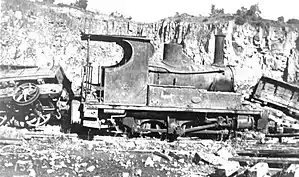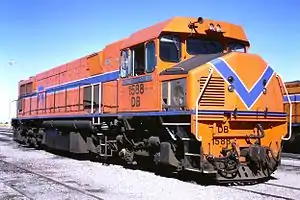WAGR S class (1888)
The WAGR S class was a two-member class of 0-6-0WT tank locomotives operated by the Great Southern Railway (GSR) and later Western Australian Government Railways (WAGR).
| WAGR S class | |||||||||||||||||||||||
|---|---|---|---|---|---|---|---|---|---|---|---|---|---|---|---|---|---|---|---|---|---|---|---|
 S162 at Prospect Quarry in the 1930s | |||||||||||||||||||||||
| |||||||||||||||||||||||
| |||||||||||||||||||||||
| |||||||||||||||||||||||
| |||||||||||||||||||||||
History
In August 1888, a Kitson & Co, Leeds built a 0-6-0WT locomotive named Princess entered service on the GSR for use in Albany, it was joined by a second named Duchess on 1 May 1892. Both were included in the December 1896 takeover of the GSR by the WAGR and became the S class, numbered S162 and S163.[1] They were withdrawn in 1915 and 1916 respectively, and later sold to the Commonwealth Government, operating construction trains at the Henderson Naval Base before moving to Canberra in 1923 during the construction of Parliament House.[2]
In 1927 both were sold to NSW Associated Blue Metal Quarries and numbered 1 and 2. The latter was scrapped in 1932 while the former having operated at Prospect Quarry, was scrapped at Bass Point Quarry, Shellharbour in 1938.[2][3]
Class list
The numbers, names and periods in service of each member of the class were as follows:[4]
|
Namesakes
The S class designation was reused when the S class locomotives were introduced in 1943. It was reused again in the 1990s when the Westrail S class diesel locomotives entered service.
See also
References
Notes
- Gunzburg 1984, pp. 38, 60.
- Turner, Jim (1997). Australian Steam Locomotives 1896-1958. Kenthurst: Kangaroo Press. p. 10. ISBN 086417778X.
- Gunzburg 1984, pp. 59–60.
- Gunzburg 1984, p. 60.
Cited works
- Gunzburg, Adrian (1984). A History of WAGR Steam Locomotives. Perth: Australian Railway Historical Society (Western Australian Division). ISBN 0959969039.
External links
![]() Media related to WAGR S class at Wikimedia Commons
Media related to WAGR S class at Wikimedia Commons


